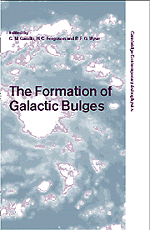Book contents
- Frontmatter
- Contents
- Preface
- Dedication: In Memory of Olin Eggen
- Part 1 Introduction
- Part 2 The Epoch of Bulge Formation
- Part 3 The Timescales of Bulge Formation
- Part 4 Physical Processes in Bulge Formation
- The Role of Bars for Secular Bulge Formation
- Bars and Boxy/Peanut-Shaped Bulges: An Observational Point of View
- Boxy- and Peanut-Shaped Bulges
- A New Class of Bulges
- The Role of Secondary Bars in Bulge Formation
- Radial Transport of Molecular Gas to the Nuclei of Spiral Galaxies
- Dynamical Evolution of Bulge Shapes
- Two-Component Stellar Systems: Phase-Space Constraints
- Central NGC 2146 – A Firehose-Type Bending Instability?
- Bulge Formation: The Role of the Multi-Phase ISM
- Global Evolution of a Self-Gravitating Multi-Phase ISM in the Central Kpc Region of Galaxies
- Part 5 Bulge Phenomenology
- Part 6 Conference Summary
- Index
Two-Component Stellar Systems: Phase-Space Constraints
from Part 4 - Physical Processes in Bulge Formation
Published online by Cambridge University Press: 10 November 2010
- Frontmatter
- Contents
- Preface
- Dedication: In Memory of Olin Eggen
- Part 1 Introduction
- Part 2 The Epoch of Bulge Formation
- Part 3 The Timescales of Bulge Formation
- Part 4 Physical Processes in Bulge Formation
- The Role of Bars for Secular Bulge Formation
- Bars and Boxy/Peanut-Shaped Bulges: An Observational Point of View
- Boxy- and Peanut-Shaped Bulges
- A New Class of Bulges
- The Role of Secondary Bars in Bulge Formation
- Radial Transport of Molecular Gas to the Nuclei of Spiral Galaxies
- Dynamical Evolution of Bulge Shapes
- Two-Component Stellar Systems: Phase-Space Constraints
- Central NGC 2146 – A Firehose-Type Bending Instability?
- Bulge Formation: The Role of the Multi-Phase ISM
- Global Evolution of a Self-Gravitating Multi-Phase ISM in the Central Kpc Region of Galaxies
- Part 5 Bulge Phenomenology
- Part 6 Conference Summary
- Index
Summary
In the context of studying the properties of the mutual mass distribution of the bright and dark matter in bulges (or elliptical galaxies), the properties of the analytical phase–space distribution function (DF) of two–component spherical self–consistent stellar systems (where one density distribution follows the Hernquist profile, and the other a γ = 0 model, with different total masses and core radii [HO models]) are here summarized. A variable amount of radial Osipkov–Merritt (OM) orbital anisotropy is allowed in both components. The necessary and sufficient conditions that the model parameters must satisfy in order to correspond to a model where each one of the two distinct components has a positive DF (the so–called model consistency) are analytically derived, together with some results on the more general problem of the consistency of two–component γ1 + γ2 models. The possibility to add in a consistent way a black hole at the center of radially anisotropic γ-models is also discussed. In the particular case of HO models, it is proved that a globally isotropic Hernquist component is consistent for any mass and core radius of the superimposed γ = 0 halo. On the contrary, only a maximum value of the core radius is allowed to the γ = 0 component when a Hernquist halo is added. The combined effect of halo concentration and orbital anisotropy is successively investigated. […]
- Type
- Chapter
- Information
- The Formation of Galactic Bulges , pp. 140 - 143Publisher: Cambridge University PressPrint publication year: 2000



